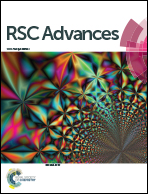Microwave-assisted chemical bath deposition process to fabricate CdS buffer layers used in Cu(In,Ga)Se2 solar cells
Abstract
A microwave-assisted chemical bath deposition process was successfully developed for preparing CdS buffer layers in Cu(In,Ga)Se2 solar cells. Crystallized CdS films with densified microstructures were formed on Cu(In,Ga)Se2 absorber layers at 55 °C. The duration of the reaction was only 4 min. Increasing the reaction temperature facilitated homogeneous precipitation and suppressed heterogeneous precipitation, thereby decreasing the thickness of CdS films, and reduced Voc, Jsc, FF, and the conversion efficiency. When CdS buffer layers were prepared at 55 °C, a conversion efficiency of 10.2% was achieved, and the corresponding values of Voc, Jsc, and FF were measured to be 0.574 V, 32.5 mA cm−2, and 55.0%, respectively. Moreover, as the reaction temperature was increased, the shunt conductance, the diode factor, and the saturated current worsened, owing to insufficient coverage of CdS films. Increasing the reaction temperature decreased the photoluminescence intensity of Cu(In,Ga)Se2 films covered by the prepared CdS films. This work demonstrates that the microwave-assisted chemical bath deposition process for preparing CdS buffer layers significantly shortened the reaction duration, and yielded high-efficiency Cu(In,Ga)Se2 solar cells.


 Please wait while we load your content...
Please wait while we load your content...